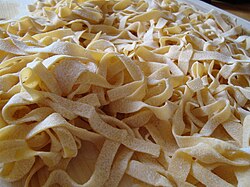Top Qs
Timeline
Chat
Perspective
Fettuccine
Type of pasta From Wikipedia, the free encyclopedia
Remove ads
Fettuccine[a] is a type of pasta popular in Roman cuisine. It is descended from the extremely thin capelli d'angelo of the Renaissance,[2] but is a flat, thick pasta traditionally made with egg and flour (usually one egg for every 100 grams or 3.5 ounces of flour). At about 6.5 mm (1⁄4 inch), it is wider and thicker than, but similar to, the tagliatelle typical of Bologna,[3][4] which are more common elsewhere in Italy and is often used as a synonym.
The terms fettucce and fettuccelle are often used as synonyms for this pasta, but the former term is more precisely used for wider (about 13 mm or 1⁄2 inch) and the latter for narrower (about 3 mm or 1⁄8 inch) forms of the same pasta.[5]
Fettuccine is often classically eaten with sugo d'umido ('beef ragù') or ragù di pollo ('chicken ragù').[4] A famous dish made with fettuccine is fettuccine Alfredo, which was created and named at a restaurant in Rome in the early 20th century as a tableside "performance".[6] It is popular in the United States, where it is made with cream, although this is almost unknown in Italy.[7][8][9][10]
Fettuccine is traditionally made fresh (either at home or commercially), but dried fettuccine can also be bought in stores.
Remove ads
See also
![]() Media related to Fettuccine at Wikimedia Commons
Media related to Fettuccine at Wikimedia Commons
Notes
- English: /ˌfɛtəˈtʃiːni/ fet-ə-CHEE-nee, UK also /ˌfɛtʊ-/ fet-uu-,[1] Italian: [fettutˈtʃiːne]; lit. 'little ribbons'; sg. fettuccina.
References
Further reading
Wikiwand - on
Seamless Wikipedia browsing. On steroids.
Remove ads

